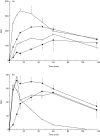Inflammatory activation of neutrophils by Helicobacter pylori; a mechanism insensitive to pertussis toxin
- PMID: 11168001
- PMCID: PMC1905959
- DOI: 10.1046/j.1365-2249.2001.01368.x
Inflammatory activation of neutrophils by Helicobacter pylori; a mechanism insensitive to pertussis toxin
Abstract
Chronic active gastritis of the antral mucosa is a characteristic feature of infection with Helicobacter pylori and interactions between bacterial components and inflammatory cells are believed to play an important pathogenic role. Neutrophils stimulated with H. pylori sonicate were demonstrated to release L-selectin (CD62L) expressed on the cellular surface, with a subsequent up-regulation of the beta2-integrins CD11b and CD11c, both in a dose- and time-dependent manner, reaching maximum levels after 45-60 min of stimulation. No changes were observed for the CD11a receptor upon stimulation. The activating properties of H. pylori sonicates on neutrophils were heat-labile and susceptible to protease attack, indicating the protein nature of the activating factor. After size fractionation, the major neutrophil-inducing activity was detected in the high molecular weight fraction exhibiting urease activity. Pertussis toxin was unable to inhibit neutrophil activation by the H. pylori protein(s). We conclude that proteins from H. pylori have a potent inflammatory effect on the surface membrane molecules CD62L, CD11b and CD11c essential for transendothelial migration of neutrophils to areas of inflammation. The neutrophil-activating protein(s) act via a pertussis toxin-insensitive mechanism.
Figures




Similar articles
-
Proinflammatory activation of neutrophils and monocytes by Helicobacter pylori in patients with different clinical presentations.Infect Immun. 1999 Jun;67(6):3171-4. doi: 10.1128/IAI.67.6.3171-3174.1999. Infect Immun. 1999. PMID: 10338540 Free PMC article.
-
Interleukin-8 expression by human neutrophils activated by Helicobacter pylori soluble proteins.Scand J Gastroenterol. 1998 Dec;33(12):1249-55. doi: 10.1080/00365529850172322. Scand J Gastroenterol. 1998. PMID: 9930387
-
Additive effects of Helicobacter pylori lipopolysaccharide and proteins in monocyte inflammatory responses.Scand J Gastroenterol. 2002 Jul;37(7):765-71. doi: 10.1080/00365520213255. Scand J Gastroenterol. 2002. PMID: 12190088
-
Immune and inflammatory responses to Helicobacter pylori infection.Scand J Gastroenterol Suppl. 1996;215:3-10. Scand J Gastroenterol Suppl. 1996. PMID: 8722376 Review.
-
Bacterial factors and immune pathogenesis in Helicobacter pylori infection.Gut. 1998 Jul;43 Suppl 1(Suppl 1):S2-5. Gut. 1998. PMID: 9764030 Free PMC article. Review.
Cited by
-
Expression of CD11c and EMR2 on neutrophils: potential diagnostic biomarkers for sepsis and systemic inflammation.Clin Exp Immunol. 2015 Nov;182(2):184-94. doi: 10.1111/cei.12679. Epub 2015 Sep 22. Clin Exp Immunol. 2015. PMID: 26153037 Free PMC article.
-
The homing receptor CD44 is involved in the progression of precancerous gastric lesions in patients infected with Helicobacter pylori and in development of mucous metaplasia in mice.Cancer Lett. 2016 Feb 1;371(1):90-8. doi: 10.1016/j.canlet.2015.10.037. Epub 2015 Nov 27. Cancer Lett. 2016. PMID: 26639196 Free PMC article.
-
Host cell responses to genotypically similar Helicobacter pylori isolates from United States and Japan.Clin Diagn Lab Immunol. 2002 Jan;9(1):167-75. doi: 10.1128/cdli.9.1.167-175.2002. Clin Diagn Lab Immunol. 2002. PMID: 11777849 Free PMC article.
References
-
- Nielsen H, Andersen LP. Activation of human phagocyte oxidative metabolism by Helicobacter pylori. Gastroenterology. 1992;103:1747–53. - PubMed
-
- Lawrence MB, Springer TA. Leucocytes roll on a selectin at physiologic flow rates: distinction from and prerequisite for adhesion through integrins. Cell. 1991;65:859–73. - PubMed
Publication types
MeSH terms
Substances
LinkOut - more resources
Full Text Sources
Other Literature Sources
Research Materials

